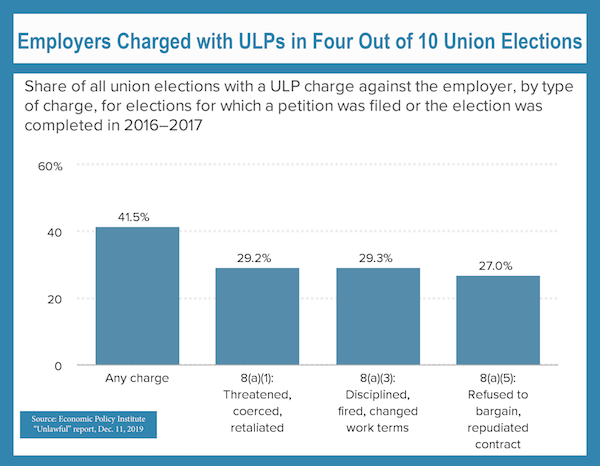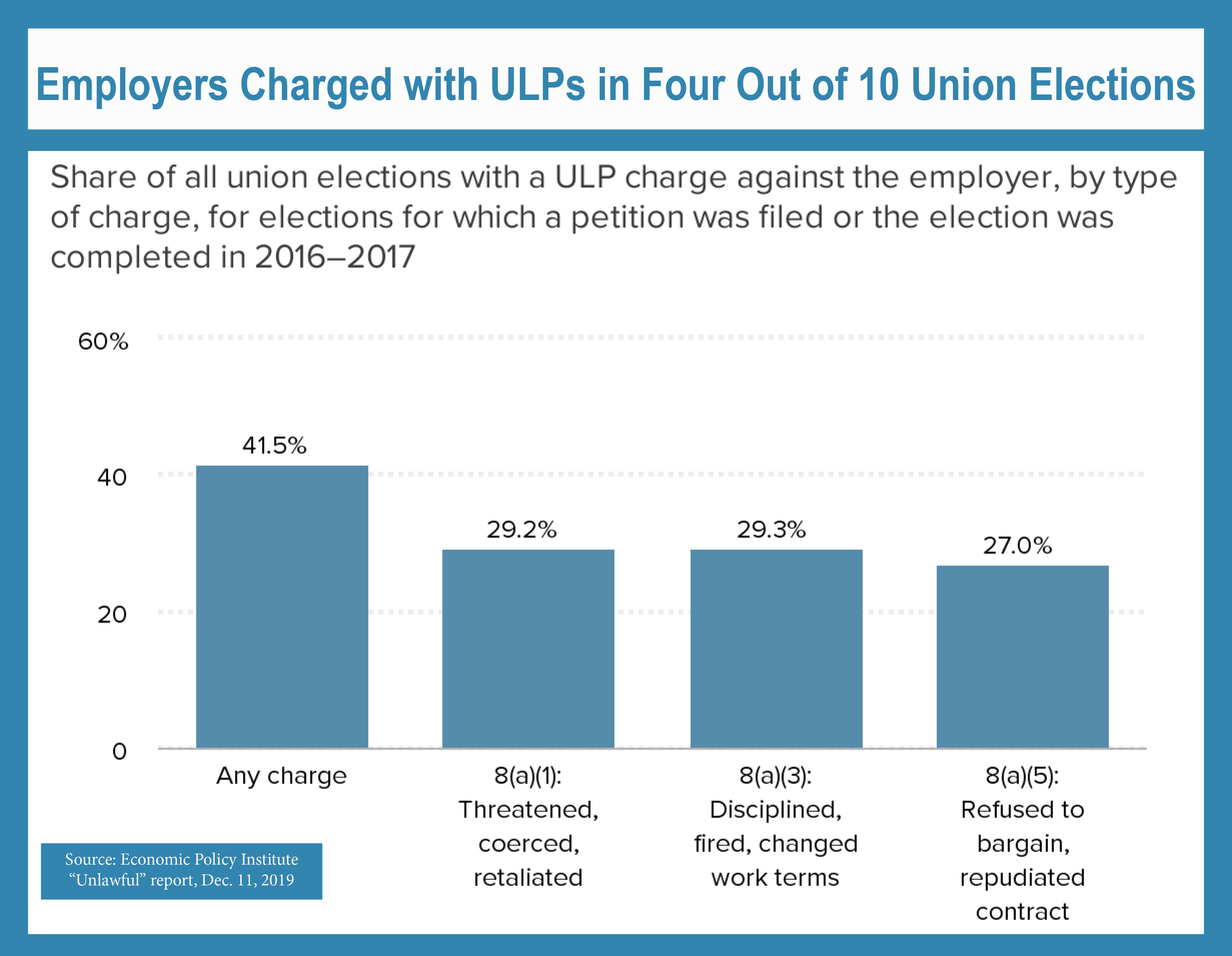U.S. employers are charged with violating federal law in
four out of 10 union election campaigns, according to a
new
Economic Policy Institute study
that also found that the nation’s private
sector spends at least $340 million a year on union-busting consultants.


|
| An Economic Policy Institute report published Dec. 11 documents that unfair labor practice charges were filed against employers in 41.5 percent of all private-sector union election campaigns in 2016 and 2017. Other evidence suggests the numbers are far higher, as many management abuses go unreported.
|
"It’s always kind of alarming to see the cold numbers of how pervasive employer opposition is to unions,” said report co-author Ben Zipperer, while cautioning that the available data doesn’t tell the full story of the uphill battle for workers’ rights.
Examining National Labor Relations Board data for 3,620 elections that were held or filed for in 2016 and 2017, researchers found that employers faced unfair labor practice charges 41.5 percent of the time.
In reality, incidents of harassment, threats, surveillance and firing of union supporters are even more prevalent, as indicated by union surveys that show vast underreporting of management abuses during campaigns.
“While these rates may seem high, it is also important to recognize they likely understate the extent of employer aggression against unions, as they cannot capture the full extent of all illegal or coercive behavior in opposing worker organizing efforts,” the report states.
Jammi Juarez, director of membership development for the IBEW’s professional and industrial division, agrees.
“In our experience, the default position for most employers is to try to derail workers who want to organize and collectively bargain for better wages, benefits and basic rights,” she said. “The fact that management’s bad behavior leads to charges only 40 percent of the time means that a lot of employers are getting away with breaking the law.”
Charges themselves are only half the battle. The report points out the well-documented hurdles of employers manipulating the legal process to delay justice and the weak remedies even when workers finally prevail.
“The penalties are totally inadequate,” Zipperer said. “It’s safe to say that labor law and enforcement of labor law is broken and it will require a massive overhaul to actually protect workers’ right to organize.”
Juarez drew a direct line between solving those problems and what happens at the ballot box. “Without more teeth in our labor laws and more enforcement it’s going to continue to be an uphill battle, and that’s not going to change until we elect political leaders who put workers first.”
The EPI study is the first in a decade to attempt to quantify charges against employers in election campaigns, finding growth in ULPs overall and for firings specifically. On average, workers are fired in 20 to 30 percent of organizing drives, with higher percentages in larger potential units, Zipperer said.
Accessing and evaluating vital data was complicated. Researchers were astonished to learn that the NLRB doesn’t track which ULP charges occur in the context of an election campaign, and had to file multiple Freedom of Information Act requests to pull data from “segregated silos,” as Zipperer put it.
“You’d think they would have the data at their fingertips,” he said, given the mission of the NLRB to protect workers’ rights, as set forth in the 1935 National Labor Relations Act.
To isolate election filings in calendar years 2016 and 2017, the EPI team had to examine nearly 50,000 cases of ULP charges against employers between fiscal years 2015 and 2018.
Gathering information on union-avoidance spending was also challenging, even though the Department of Labor requires employers to report what they pay anti-union consultants and lawyers. Zipperer said it is largely a “shadow industry.”
“We were able to download what was publicly available, but we know that it massively underreports the amount of spending,” he said, calling the $340 million annual figure “a conservative estimate.”
He noted that the DOL attempted its own study in 2011 “and made a determination that in their judgement, only 7 to 8 percent of funding that employers are supposed to report was being reported.”
“It goes to the larger point that there is not a rigorous, complete, exhaustive requirement that ensures we know how much employers are doing to oppose unions,” he said.
The EPI report links aggressive and largely unchecked union-busting to “the extreme inequality that marks the American economy,” citing a 940% explosion in CEO pay since 1978, compared to 12% growth for workers.
“The record is extremely clear,” Zipperer said. “When unions have enough bargaining power, they deliver the benefits they promise to workers, which has positive spillover for the non-union sector. The same thing is true in reverse. When unions don’t have that power, you really start to see the consequences in terms of wage stagnation and other difficulties for union and non-union workers alike.”